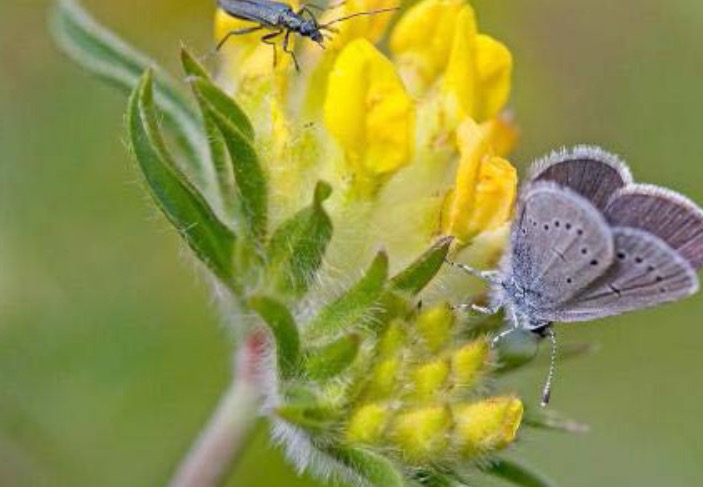Southam Quarry
CEMEX UK has partnered with Butterfly Conservation to create habitats for threatened species at its Southam quarry in Warwickshire. The work has been so successful in increasing butterfly numbers that CEMEX now promotes best practice in land management to other businesses in the local area.

A Small Blue Butterfly on Kidney Vetch, one of the species found at Southam
Rare species found at Southam Quarry:
- Small Blue Butterfly
- Chalk Carpet Moth
- Dingy Skipper Butterfly
- Grizzled Skipper Butterfly
"Our partnership with CEMEX UK has already seen major successes, including an increase in the number of Small Blue butterfly colonies from three to six and the number of Chalk Carpet moth sites from one to three."
Keith Warmington, Chairman, Butterfly Conservation, Warwickshire.
CEMEX relies on raw materials such as limestone, sand, gravel and clay to make its cement and concrete products. These are essential for building the roads, schools and homes that society needs, but quarrying the materials has the potential to degrade habitats and damage species unless the land is carefully managed. We are determined to have a positive impact on nature by promoting a diverse range of habitats and species while quarries are active, and by rehabilitating disused sites. By restoring former quarry sites we also provide communities with new nature reserves and education and leisure facilities.
The Southam Quarry is one of many CEMEX UK sites that we are rehabilitating. Quarrying for limestone and clay has taken place at Southam since the 1800s. There are a number of active quarries at the site today, providing much of the raw material for our cement plant in nearby Rugby.
Southam is a priority area for biodiversity conservation because the soil is alkaline. This encourages grassland rich in flowers - an important habitat for insects and butterflies. Several types of butterfly and moth are considered priority species by the UK Government's Biodiversity Action Plan (UK BAP), a nationwide programme that identifies and protects threatened wildlife and habitats. We partnered with Butterfly Conservation, which works to halt the decline in butterfly and moth numbers, to create conditions that support threatened butterfly and moth species at Southam.
After consulting local stakeholders, we mapped the site to gain a detailed understanding of the species and habitats present. We used this information to produce a biodiversity management plan for making the area more attractive to butterflies and moths.
We sowed locally sourced seeds to create grassland rich in flowers and we planted Kidney Vetch, a flower that helps the Small Blue butterfly to thrive. We cleared approximately three hectares of scrub and built banks of earth, creating several different habitats within a small area to attract a range of species.
Butterfly Conservation used the site to trial conservation methods. They created micro-habitats for insects and introduced [what type of grazing species - cow, sheep, horses?] to graze the area under careful management, as this can encourage different types of grass to grow. Together, we monitored the effectiveness of different conservation activities and shared the results with the wider conservation community, other extraction companies, local authorities and schools.
We created 1.5 hectares of diverse grassland to support butterflies and moths, and their numbers increased significantly as a result. In particular, the number of colonies of Small Blue butterflies doubled from three to six. The UK BAP has a local target for increasing Small Blue numbers - and the colonies at Southam make up 75% of this target. Populations of the Dingy Skipper butterfly and the Chalk Carpet Moth have also increased by a third.
Lessons Learned
Restoring the Southam Quarry substantially increased our understanding of land management. We now know it's possible to create ideal habitats for rare and threatened insects through restoring a quarry site.
We are confident that focusing conservation efforts on UK BAP priority habitats and species promotes the best outcome for biodiversity. Partnering with a local conservation organisation is key to making real progress at individual sites. We also know that with the help of volunteer ecologists, it's possible to monitor the benefits for species and improve our understanding of conservation methods.
We plan to increase further the amount of grassland at the site to encourage more threatened butterfly and moth species into the area. We will continue to support the UK BAP targets for the Small Blue and other priority species and are sure that butterfly populations will spread out beyond our site and into the local area in the future.
With help from experts at the Royal Society for the Protection of Birds (RSPB), we have developed an ambitious ten-year biodiversity strategy. This sets challenging targets, including our goal to create and maintain, by 2020, 1,000 hectares of habitats identified by the UK Government as conservation priorities.
For more information please contact us.
